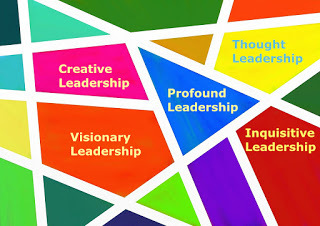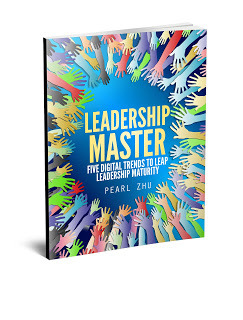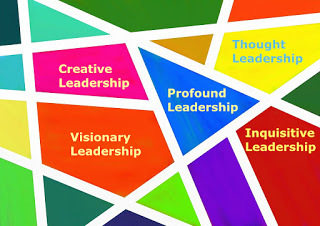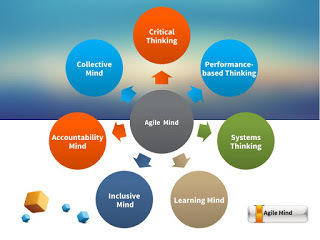Pearl Zhu's Blog, page 1328
June 14, 2016
The New Book “Leadership Master" Introduction Chapter 1 Thought Leadership
A Thought Leader is someone who looks at the future and sets a course for others to follow.
 As a verb, Thought Leadership can be best offered as a state of mind. Thought Leadership is the ability to assimilate knowledge, to think with knowledge, but transcends to insight and wisdom. At today’s digital dynamic with increasing speed of changes, uncertainty, and hyper-competition, being a thoughtful, mindful and multi-dimensional thinker is more crucial to improve leadership effectiveness. In chapter I of "Leadership Master," we brainstorm the multifaceted Thought Leadership and summarize thirteen flavors of digital leadership.
As a verb, Thought Leadership can be best offered as a state of mind. Thought Leadership is the ability to assimilate knowledge, to think with knowledge, but transcends to insight and wisdom. At today’s digital dynamic with increasing speed of changes, uncertainty, and hyper-competition, being a thoughtful, mindful and multi-dimensional thinker is more crucial to improve leadership effectiveness. In chapter I of "Leadership Master," we brainstorm the multifaceted Thought Leadership and summarize thirteen flavors of digital leadership.
Who are Thought Leaders? A Thought Leader is someone who looks at the future and sets a course for others to follow. Thought Leaders are often challenging conventional thinking and current best practices, it could be a process, a methodology, a practice, a system, a philosophy, etc. to which the Thought Leader adds a new insight and perspective. Digital leadership is less about “HOW,” more about “WHY,” and “WHAT.” Leadership brand is less about what you look, the stereotypical leadership, and more about what you think - the thought leadership. Thought Leadership is one of the most authentic digital leadership characteristics. Thought leadership by definition is transformative, even if it sometimes requires redefining the old in ways that make things new. Thought Leaders are explorers. Thought Leadership expands the boundaries, calls for the boundaries of current thinking to be challenged in either macro or micro way. Thought Leadership is by nature evolutionary in that it must always be part of an ever-evolving flow.
Authentic Leadership: Authenticity is the most fundamental, but challenging attribute for leadership effectiveness. Great leaders are both nature and nurtured. They may encounter certain life events to inspire them to become leaders, which is the nature way, but in a more nurtured logic, what transforms them is in how they aware, adapt and are able to make changes. And they can perceive, interact, interpret, and are intelligent to understand what makes them exceptional leaders. The authentic leaders with high intelligence have adaptability, consistency, and empathy to master business dynamic and culture differences, also practice thought leadership in a nature way. Great leaders are not afraid to follow as well. If you are leading and not willing to learn, growth and share, and then you are just talking the talk without leadership effectiveness. Leadership is the influence, the authentic leaders make their influence via interpreting vision clearly, make proactive interaction, build differentiated capability, and practice leadership disciple via awareness and adaptability.
Influential competency: The Thought Leaders can amplify leadership influence via sharing vision and insight.The leaders and managers with influential competence will be more flexible and less rigidly tied to top-down, command and control environment. Instead, they encourage open debates and critical thinking and value collective wisdom. Knowledge tends to be linear, but wisdom is often multidimensional.A wise thought leader doesn’t always know everything, but he or she always has the curiosity to understand things deeper or look at things from different angle. Plus an open mind - wisdom is a function of knowing what you don’t know and keeps curiosity to know more.
In this chapter of the book“Leadership Master,” we summarized thirteen types of leadership with unique strength, differentiated capability, and positive influence. Real Thought Leadership is a human capacity with the long-term perspective. Thought Leadership is influential, the Thought Leaders are mostly visionary, trusted advisors, subject matter experts or futurists, and they are change agents and digital transformation champions.
"Digital Master" Book Series Slideshare Introduction "Leadership Master" Introduction Slideshare Presentation " Leadership Master " Introduction Blog "Leadership Master" Chapter I Introduction
" Leadership Master " Amazon Order Link " Leadership Master " B&N Order Link " Leadership Master " IBook Order Link Follow us at: @Pearl_Zhu
 As a verb, Thought Leadership can be best offered as a state of mind. Thought Leadership is the ability to assimilate knowledge, to think with knowledge, but transcends to insight and wisdom. At today’s digital dynamic with increasing speed of changes, uncertainty, and hyper-competition, being a thoughtful, mindful and multi-dimensional thinker is more crucial to improve leadership effectiveness. In chapter I of "Leadership Master," we brainstorm the multifaceted Thought Leadership and summarize thirteen flavors of digital leadership.
As a verb, Thought Leadership can be best offered as a state of mind. Thought Leadership is the ability to assimilate knowledge, to think with knowledge, but transcends to insight and wisdom. At today’s digital dynamic with increasing speed of changes, uncertainty, and hyper-competition, being a thoughtful, mindful and multi-dimensional thinker is more crucial to improve leadership effectiveness. In chapter I of "Leadership Master," we brainstorm the multifaceted Thought Leadership and summarize thirteen flavors of digital leadership.Who are Thought Leaders? A Thought Leader is someone who looks at the future and sets a course for others to follow. Thought Leaders are often challenging conventional thinking and current best practices, it could be a process, a methodology, a practice, a system, a philosophy, etc. to which the Thought Leader adds a new insight and perspective. Digital leadership is less about “HOW,” more about “WHY,” and “WHAT.” Leadership brand is less about what you look, the stereotypical leadership, and more about what you think - the thought leadership. Thought Leadership is one of the most authentic digital leadership characteristics. Thought leadership by definition is transformative, even if it sometimes requires redefining the old in ways that make things new. Thought Leaders are explorers. Thought Leadership expands the boundaries, calls for the boundaries of current thinking to be challenged in either macro or micro way. Thought Leadership is by nature evolutionary in that it must always be part of an ever-evolving flow.
Authentic Leadership: Authenticity is the most fundamental, but challenging attribute for leadership effectiveness. Great leaders are both nature and nurtured. They may encounter certain life events to inspire them to become leaders, which is the nature way, but in a more nurtured logic, what transforms them is in how they aware, adapt and are able to make changes. And they can perceive, interact, interpret, and are intelligent to understand what makes them exceptional leaders. The authentic leaders with high intelligence have adaptability, consistency, and empathy to master business dynamic and culture differences, also practice thought leadership in a nature way. Great leaders are not afraid to follow as well. If you are leading and not willing to learn, growth and share, and then you are just talking the talk without leadership effectiveness. Leadership is the influence, the authentic leaders make their influence via interpreting vision clearly, make proactive interaction, build differentiated capability, and practice leadership disciple via awareness and adaptability.

Influential competency: The Thought Leaders can amplify leadership influence via sharing vision and insight.The leaders and managers with influential competence will be more flexible and less rigidly tied to top-down, command and control environment. Instead, they encourage open debates and critical thinking and value collective wisdom. Knowledge tends to be linear, but wisdom is often multidimensional.A wise thought leader doesn’t always know everything, but he or she always has the curiosity to understand things deeper or look at things from different angle. Plus an open mind - wisdom is a function of knowing what you don’t know and keeps curiosity to know more.
In this chapter of the book“Leadership Master,” we summarized thirteen types of leadership with unique strength, differentiated capability, and positive influence. Real Thought Leadership is a human capacity with the long-term perspective. Thought Leadership is influential, the Thought Leaders are mostly visionary, trusted advisors, subject matter experts or futurists, and they are change agents and digital transformation champions.
"Digital Master" Book Series Slideshare Introduction "Leadership Master" Introduction Slideshare Presentation " Leadership Master " Introduction Blog "Leadership Master" Chapter I Introduction
" Leadership Master " Amazon Order Link " Leadership Master " B&N Order Link " Leadership Master " IBook Order Link Follow us at: @Pearl_Zhu
Published on June 14, 2016 23:39
The New Book “Leadership Master - Five Emergent Digital Trends to Leap Leadership Maturity” Introduction Chapter 1 Thought Leadership
 As a verb, Thought Leadership can best be offered as a state of mind. Thought Leadership is the ability to assimilate knowledge, to think with knowledge, but transcends to insight and wisdom. At today’s digital dynamic with increasing speed of changes and hyper-competition, being a thoughtful, mindful and multi-dimensional thinker is more crucial to improve leadership effectiveness.
As a verb, Thought Leadership can best be offered as a state of mind. Thought Leadership is the ability to assimilate knowledge, to think with knowledge, but transcends to insight and wisdom. At today’s digital dynamic with increasing speed of changes and hyper-competition, being a thoughtful, mindful and multi-dimensional thinker is more crucial to improve leadership effectiveness.
Who are Thought Leaders? A Thought Leader is someone who looks at the future and sets a course for others to follow, Thought Leaders are often challenging conventional thinking and current best practices, it could be a process, a methodology, a practice, a system, a philosophy, etc. to which the Thought Lead adds a new insight and perspective. Thought Leadership is one of the most authentic digital leadership characteristics. Digital leadership is less about “HOW,” more about “WHY,” and “WHAT.” Leadership brand is less about what you look, the stereotypical leadership, and more about what you think. Thought leadership by definition is transformative, even if it sometimes requires redefining the old in ways that make things new. Thought Leaders are explorers, Thought Leaders are explorers, Thought Leadership expands the boundaries, calls for the boundaries of current thinking to be challenged in either macro or micro way. Thought Leadership is by nature evolutionary in that it must always be part of an ever-evolving flow.
Authentic Leadership: Authenticity is the most fundamental, but challenging attribute for leadership effectiveness. Great leaders are both nature and nurtured. They may encounter certain life events to inspire them to become leaders, which is the nature way, but in a more nurtured logic, what transforms them is in how they aware, adapt and are able to make changes. And they can perceive, interact, interpret, and are intelligent to understand what makes them exceptional leaders. The authentic leaders with high intelligence have adaptability, consistency, and empathy to master business dynamic and culture differences, also practice thought leadership in a nature way. Great leaders are also not afraid to follow as well, if you are leading and not willing to learn, growth and share, and then you are just talking the talk without leadership effectiveness. Leadership is the influence, the authentic leaders make their influence via interpreting vision clearly, make proactive interaction, build differentiated capability, and practice leadership disciple via awareness and adaptability.

Influential competency: The thought leaders can amplify leadership influence via sharing vision and insight. The leaders and managers with influential competence will be more flexible and less rigidly tied to top-down, command and control environment. Instead, they encourage open debates and critical thinking and value collective wisdom. Knowledge tends to be linear, but wisdom is often multidimensional A wise thought leader doesn’t always know everything, but he or she always has the curiosity to understand things deeper or look at things from different angle. Plus an open mind - wisdom is a function of knowing what you don’t know and keeps curiosity to know more.
In this chapter of “Leadership Master,” we summarized thirteen types of leadership with unique strength, differentiated capability, and positive influence. Real Thought Leadership is a human capacity with long-term perspective. Thought Leadership is influential, the Thought Leaders are mostly visionary, trusted advisors, subject matter experts or futurists, and they are change agents and digital transformation champions.Follow us at: @Pearl_Zhu
Published on June 14, 2016 23:39
"CIO Master" Book Tuning XXXVII Three “RIGHT” Elements in Running Digital IT
The RIGHT people deliver the right information with the right speed enable IT to shift into a digital mode.
 Forward-thinking organizations are reinventing the tarnished image of IT as a digital laggard, and transform IT from a cost center to a value creator, from a maintenance support function to a proactive innovation engine, and ensure it is doing the RIGHT things in the RIGHT way. Here are three “RIGHT” elements in running digital IT.
Forward-thinking organizations are reinventing the tarnished image of IT as a digital laggard, and transform IT from a cost center to a value creator, from a maintenance support function to a proactive innovation engine, and ensure it is doing the RIGHT things in the RIGHT way. Here are three “RIGHT” elements in running digital IT.
Deliver the RIGHT information: IT is the information steward of the modern business. Managing information and the information position of an organization is what ought to be called Information Management. Information Management is to connect people with the right information at the right time & location, to ensure that accurate information is accessible and shared within relevant business functions to make the right decisions. Nowadays, information is the lifeblood of digital business, Information Management is about processing information to ensure that information has the right quality (accurate, right, integrated, complete,...), that the information is used properly with effective risk management. Today the recognition of Information Management is maturing with boards being educated on the power of information adding to the bottom line and top line business growth. Therefore, one of the critical responsibilities for IT is to break down information silo, manage information in the right way and extract its business value cost-effectively.
Running IT with the RIGHT speed: The emergent digital technologies are often the disruptive forces of digital transformation. Unfortunately, many IT organizations have been perceived by business partners as being too slow to change, and there are gaps created between IT and the rest of the company. Digitizing IT means to speed up, adapt to changes, and keep optimizing. How to run IT with the RIGHT speed: fast enough to ride above the learning curve and lead change, but also steady & solid, to keep the business running smoothly. More and more businesses expect the consumerization style responsiveness from IT. Many IT departments operate in silos with separate teams delivering separate functional tasks: backup, monitoring, administration, risk control. Effective automation should first examine these functions and understand the connections and define any constraints in the system. Running IT with the RIGHT speed means that IT has to not only improve its own speed, but also overall organizational agility to close the gaps between IT and business. IT needs to ensure its strategy can be achieved with the full digital speed.
 The RIGHT people with the RIGHT mindset, capabilities, and skills: IT talent shortage and skills gap is a reality, not fiction. This is particularly true at the journey of digital transformation. Because IT is no longer just a support center or help desk. IT leadership needs to be more innovative and transformative, and IT professionals have to learn the new skills and the new capabilities to adapt to the digital new normal. In this regard, the RIGHT way is to explore the new possibilities and discover the BETTER way to solve problems. From IT talent management perspectives, it’s important to identify the skill gaps and define the technical/functional competencies required to achieve business goals. From culture innovation perspective, IT leaders always should ask themselves whether the workplace is healthy enough to attract the best and brightest, and how to unleash the collective human potential for achieving the high-performing business result for the long term. Building the digital pipeline to complement traditional HR management practices. Find the right people through what they think and how they act, and integrate talent management, culture management, and performance management into a holistic people management approach for having the right people in the right position to do the right things.
The RIGHT people with the RIGHT mindset, capabilities, and skills: IT talent shortage and skills gap is a reality, not fiction. This is particularly true at the journey of digital transformation. Because IT is no longer just a support center or help desk. IT leadership needs to be more innovative and transformative, and IT professionals have to learn the new skills and the new capabilities to adapt to the digital new normal. In this regard, the RIGHT way is to explore the new possibilities and discover the BETTER way to solve problems. From IT talent management perspectives, it’s important to identify the skill gaps and define the technical/functional competencies required to achieve business goals. From culture innovation perspective, IT leaders always should ask themselves whether the workplace is healthy enough to attract the best and brightest, and how to unleash the collective human potential for achieving the high-performing business result for the long term. Building the digital pipeline to complement traditional HR management practices. Find the right people through what they think and how they act, and integrate talent management, culture management, and performance management into a holistic people management approach for having the right people in the right position to do the right things.
The RIGHT speed keeps IT dynamic, not static; the RIGHT IT leadership drives changes, not just reacts to the business requests; the RIGHT IT talent is learning agile, keeps building the new skills and capabilities and improve IT/business effectiveness and efficiency, and the RIGHT information IT delivers can help business to oversight business operation, also capture customer insight and business foresight for businesses’ long-term prosperity.
CIO Master Order Link on Amazon CIO Master Ordre Link on Barner & Noble CIO Master Order Link On IBooks “CIO Master” Book Preview Quote Collection III “CIO Master” Book Preview Quote Collection II “CIO Master” Book Preview Quote Collection I, Slideshare Presentation “CIO Master” Book Preview Conclusion Running IT as Digital Transformer “CIO Master” Book Preview: Chapter 9 IT Agility “CIO Master” Book Preview: Chapter 8 Three "P"s in Running Digital IT “CIO Master” Book Preview: Chapter 7 IT Innovation Management “CIO Master” Book Preview: Chapter 6 Digital Strategy-Execution Continuum "CIO Master” Book Preview: Chapter 5 Thirteen Digital Flavored IT “CIO Master” Book Preview: Chapter 4 CIO as Talent Master Introduction “CIO Master” Book Preview: Chapter 3 “CIOs as Change Agent” Introduction “CIO Master” Book Preview: Chapter 2 “CIOs as Digital Visionary” Introduction “CIO Master” Book Preview: Chapter 1 “Twelve Digital CIO Personas” Introduction "CIO Master - Unleash the Digital Potential of IT" Introduction "CIO Master - Unleash the Digital Potential of IT" Book Preview
Follow us at: @Pearl_Zhu
 Forward-thinking organizations are reinventing the tarnished image of IT as a digital laggard, and transform IT from a cost center to a value creator, from a maintenance support function to a proactive innovation engine, and ensure it is doing the RIGHT things in the RIGHT way. Here are three “RIGHT” elements in running digital IT.
Forward-thinking organizations are reinventing the tarnished image of IT as a digital laggard, and transform IT from a cost center to a value creator, from a maintenance support function to a proactive innovation engine, and ensure it is doing the RIGHT things in the RIGHT way. Here are three “RIGHT” elements in running digital IT.
Deliver the RIGHT information: IT is the information steward of the modern business. Managing information and the information position of an organization is what ought to be called Information Management. Information Management is to connect people with the right information at the right time & location, to ensure that accurate information is accessible and shared within relevant business functions to make the right decisions. Nowadays, information is the lifeblood of digital business, Information Management is about processing information to ensure that information has the right quality (accurate, right, integrated, complete,...), that the information is used properly with effective risk management. Today the recognition of Information Management is maturing with boards being educated on the power of information adding to the bottom line and top line business growth. Therefore, one of the critical responsibilities for IT is to break down information silo, manage information in the right way and extract its business value cost-effectively.
Running IT with the RIGHT speed: The emergent digital technologies are often the disruptive forces of digital transformation. Unfortunately, many IT organizations have been perceived by business partners as being too slow to change, and there are gaps created between IT and the rest of the company. Digitizing IT means to speed up, adapt to changes, and keep optimizing. How to run IT with the RIGHT speed: fast enough to ride above the learning curve and lead change, but also steady & solid, to keep the business running smoothly. More and more businesses expect the consumerization style responsiveness from IT. Many IT departments operate in silos with separate teams delivering separate functional tasks: backup, monitoring, administration, risk control. Effective automation should first examine these functions and understand the connections and define any constraints in the system. Running IT with the RIGHT speed means that IT has to not only improve its own speed, but also overall organizational agility to close the gaps between IT and business. IT needs to ensure its strategy can be achieved with the full digital speed.
 The RIGHT people with the RIGHT mindset, capabilities, and skills: IT talent shortage and skills gap is a reality, not fiction. This is particularly true at the journey of digital transformation. Because IT is no longer just a support center or help desk. IT leadership needs to be more innovative and transformative, and IT professionals have to learn the new skills and the new capabilities to adapt to the digital new normal. In this regard, the RIGHT way is to explore the new possibilities and discover the BETTER way to solve problems. From IT talent management perspectives, it’s important to identify the skill gaps and define the technical/functional competencies required to achieve business goals. From culture innovation perspective, IT leaders always should ask themselves whether the workplace is healthy enough to attract the best and brightest, and how to unleash the collective human potential for achieving the high-performing business result for the long term. Building the digital pipeline to complement traditional HR management practices. Find the right people through what they think and how they act, and integrate talent management, culture management, and performance management into a holistic people management approach for having the right people in the right position to do the right things.
The RIGHT people with the RIGHT mindset, capabilities, and skills: IT talent shortage and skills gap is a reality, not fiction. This is particularly true at the journey of digital transformation. Because IT is no longer just a support center or help desk. IT leadership needs to be more innovative and transformative, and IT professionals have to learn the new skills and the new capabilities to adapt to the digital new normal. In this regard, the RIGHT way is to explore the new possibilities and discover the BETTER way to solve problems. From IT talent management perspectives, it’s important to identify the skill gaps and define the technical/functional competencies required to achieve business goals. From culture innovation perspective, IT leaders always should ask themselves whether the workplace is healthy enough to attract the best and brightest, and how to unleash the collective human potential for achieving the high-performing business result for the long term. Building the digital pipeline to complement traditional HR management practices. Find the right people through what they think and how they act, and integrate talent management, culture management, and performance management into a holistic people management approach for having the right people in the right position to do the right things.
The RIGHT speed keeps IT dynamic, not static; the RIGHT IT leadership drives changes, not just reacts to the business requests; the RIGHT IT talent is learning agile, keeps building the new skills and capabilities and improve IT/business effectiveness and efficiency, and the RIGHT information IT delivers can help business to oversight business operation, also capture customer insight and business foresight for businesses’ long-term prosperity.
CIO Master Order Link on Amazon CIO Master Ordre Link on Barner & Noble CIO Master Order Link On IBooks “CIO Master” Book Preview Quote Collection III “CIO Master” Book Preview Quote Collection II “CIO Master” Book Preview Quote Collection I, Slideshare Presentation “CIO Master” Book Preview Conclusion Running IT as Digital Transformer “CIO Master” Book Preview: Chapter 9 IT Agility “CIO Master” Book Preview: Chapter 8 Three "P"s in Running Digital IT “CIO Master” Book Preview: Chapter 7 IT Innovation Management “CIO Master” Book Preview: Chapter 6 Digital Strategy-Execution Continuum "CIO Master” Book Preview: Chapter 5 Thirteen Digital Flavored IT “CIO Master” Book Preview: Chapter 4 CIO as Talent Master Introduction “CIO Master” Book Preview: Chapter 3 “CIOs as Change Agent” Introduction “CIO Master” Book Preview: Chapter 2 “CIOs as Digital Visionary” Introduction “CIO Master” Book Preview: Chapter 1 “Twelve Digital CIO Personas” Introduction "CIO Master - Unleash the Digital Potential of IT" Introduction "CIO Master - Unleash the Digital Potential of IT" Book Preview
Follow us at: @Pearl_Zhu
Published on June 14, 2016 23:34
Three “RIGHT” Elements in Running Digital IT
 Forward-thinking organizations are reinventing the IT tarnished image, and transform IT from a cost center to a value creator, from a maintenance support function to a proactive innovation engine, and ensure it is doing the RIGHT things in the RIGHT way. Here are three “RIGHT” Elements in running digital IT.
Forward-thinking organizations are reinventing the IT tarnished image, and transform IT from a cost center to a value creator, from a maintenance support function to a proactive innovation engine, and ensure it is doing the RIGHT things in the RIGHT way. Here are three “RIGHT” Elements in running digital IT.
Deliver the RIGHT information: IT is the information steward of the modern business. Managing the information and the information position of an organization is what ought to be called Information Management. Information Management is to connect people with the right information at the right time & location, to ensure that accurate information is accessible and shared within relevant business functions to make the right decisions. Nowadays, information is the lifeblood of digital business, Information Management is about processing information to ensure that information has the right quality (accurate, right, integrated, complete,...), that the information is used properly with effective risk management. Today the recognition of information management is maturing with boards being educated on the power of information adding to the bottom line & top line business growth. Therefore, one of the critical responsibilities for IT is to break down information silo, manage information and extract its business value cost-effectively.
Running IT with the RIGHT speed: The emergent digital technologies are the disruptive forces of digital transformation. Unfortunately, many IT organizations have been perceived by business partners as being slow to change, and there are gaps created between IT and the rest of the company. Digitizing IT means to speed up, adapt to changes, and keep optimizing. How to run IT with the RIGHT speed: fast enough to ride above the learning curve and lead change, but also steady, to keep the business running smoothly. More and more businesses expect the consumerization style responsiveness from IT. Many IT departments operate in silos with separate teams delivering separate functional tasks: backup, monitoring, administration, risk control. Effective automation should first examine these functions and understand the connections and define any constraints in the system. Running IT with the RIGHT speed means that IT has to not only improve its own speed, but also overall organizational agility to close the gaps between IT and business. IT needs to ensure its strategy allowing for digital speed.
 The RIGHT people with the right mindset, capabilities, and skills: IT talent shortage and skills gap is a reality, not fiction. This is particularly true at the journey of digital transformation. Because IT is no longer just a support center or help desk. IT leadership needs to be more innovative and transformative, and IT professionals have to learn the new skills and business the new capabilities to adapt to the digital new normal, in this regard, the RIGHT way is to explore the new possibilities, and discover the BETTER way to solve problems. From IT talent management perspectives, it’s important to identify the skill gaps and define the technical/functional competencies required to achieve business goals. From culture innovation perspective, IT leaders always should ask themselves whether the workplace is healthy enough to attract the best and brightest, and how to unleash the collective human potential for achieving a high-performing business result for the long term. Building the digital pipeline to complement traditional HR management practices. Find the right people through what they think and how they act, and integrate talent management, culture management, and performance management into a holistic people management approach in having the right people in the right position to do the right things.
The RIGHT people with the right mindset, capabilities, and skills: IT talent shortage and skills gap is a reality, not fiction. This is particularly true at the journey of digital transformation. Because IT is no longer just a support center or help desk. IT leadership needs to be more innovative and transformative, and IT professionals have to learn the new skills and business the new capabilities to adapt to the digital new normal, in this regard, the RIGHT way is to explore the new possibilities, and discover the BETTER way to solve problems. From IT talent management perspectives, it’s important to identify the skill gaps and define the technical/functional competencies required to achieve business goals. From culture innovation perspective, IT leaders always should ask themselves whether the workplace is healthy enough to attract the best and brightest, and how to unleash the collective human potential for achieving a high-performing business result for the long term. Building the digital pipeline to complement traditional HR management practices. Find the right people through what they think and how they act, and integrate talent management, culture management, and performance management into a holistic people management approach in having the right people in the right position to do the right things.
The RIGHT speed keeps IT dynamic, not static; the RIGHT IT leadership drives changes, not just reacts to the business requests; the RIGHT IT talent is learning agile, keeps building the new skills and capabilities and improve IT/business effectiveness and efficiency, and the RIGHT information IT delivers can help business to oversight business operation, also capture customer insight and business foresight for businesses’ long-term prosperity.
Follow us at: @Pearl_Zhu
Published on June 14, 2016 23:34
June 13, 2016
The Monthly Sum Up of Enterprise Capabilities June, 2016
Decision making is the arena across the art and science; gut feeling and data driven, confidence and humility.
 Making a decision is one of the significant tasks for business leadership, however, the high ratio of strategic decisions have been made poorly and cause the catastrophic effect. How to avoid such decision pitfalls, to make effective decisions both strategically and tactically?
Making a decision is one of the significant tasks for business leadership, however, the high ratio of strategic decisions have been made poorly and cause the catastrophic effect. How to avoid such decision pitfalls, to make effective decisions both strategically and tactically?
Running IT as Digital Capability Builder of the Organization? Forward-looking organizations are making a continuous journey shifting from an inside-out operation driven organization to an outside-in customer-centric business; to improve competency, they also shift from process-oriented practices to capability-based strategy management. IT plays a more important role in such a digital paradigm shift. The capability is the ability to achieve the desired effect under specified performance, standards and conditions through combinations of ways and means (activities and resources) to perform a set of activities. What are differentiated business capabilities can IT help to build for business to gain long term advantage?
Five Capability Blocks to Build Digital Competency People are always the most invaluable asset in any organizations. The forward-thinking digital organizations these days look for such hybrid talent, who has the digital fit mindset, the right balance of learning style, character and energy within the team; and who has well set of capabilities needed with digital speed. Due to the changing nature of technology and accelerating speed of business changes, among the most pervasive and persistent concerns from IT leaders are skills gaps, the complaints include that people do not have the right competencies, they can’t find the right skills to fill the positions, etc. Is IT skills gap fact or fiction? What are the most important capabilities for digital professionals to survive and thrive in today’s fast-changing business dynamic?
Three Business Capabilities to Differentiate a Digital Leader from Laggards Digital transformation is a journey, from digital strategy crafting to organizational structure tuning, it has to permeate into business strategy and vision, mindset, and action, culture and communication, process and capability, etc. A business capability is the set of abilities needed by an organization to do things effectively to achieve desired outcomes, measurable benefits and fulfill business demand consistently. In today’s digital paradigm, digital capabilities are also the building blocks to shift an organization from a reactive surviving mode to proactive thriving mode, here is a set of business capabilities to differentiate a digital leader from laggards.
Dynamic Capability as Resource: The dynamic capabilities' are defined as: "the firm's ability to integrate, build, and reconfigure internal and external competences to address rapidly changing environments." With the increasing speed of changes and unprecedented uncertainty, dynamic capabilities thus reflect an organization's ability to adapt to changes, build new capability, and achieve innovative forms of competitive advantage given path dependencies and market positions. Do 'Dynamic Capabilities' (DCs) qualify as a business resource? Is DC a firm-specific asset that is difficult if not impossible to imitate?
Change as an Ongoing Capability” Change is a volatile subject, just like change itself. Everything changes continuously by following the laws of evolution, and the rate of change is accelerated. Corporate change can be a simple modification of strategy, a business process improvement or a more radical digital transformation. Either at the individual or organizational level, at the more static industrial era, change is a one-time project; at digital age, change has to become an ongoing capability.
 The blog is a dynamic book flowing with your thought; growing through your dedication; sharing your knowledge; conveying your wisdom, and making influence through touching the hearts and connecting the minds across the globe. The “Future of CIO” Blog has reached 1.3 million page views with about #2800 blog posting. Among 59+ different categories of leadership, management, strategy, digitalization, change/talent, etc. Blogging is not about writing, but about thinking and innovating the new ideas; it’s not just about WHAT to say, but about WHY to say, and HOW to say it. It reflects the color and shade of your thought patterns, and it indicates the peaks and curves of your thinking waves. Unlike pure entertainment, quality and professional content takes time for digesting, contemplation and engaging, and therefore, it takes the time to attract the "hungry minds" and the "deep souls." It’s the journey to amplify diverse voices and deepen digital footprints, and it's the way to harness your innovative spirit.
The blog is a dynamic book flowing with your thought; growing through your dedication; sharing your knowledge; conveying your wisdom, and making influence through touching the hearts and connecting the minds across the globe. The “Future of CIO” Blog has reached 1.3 million page views with about #2800 blog posting. Among 59+ different categories of leadership, management, strategy, digitalization, change/talent, etc. Blogging is not about writing, but about thinking and innovating the new ideas; it’s not just about WHAT to say, but about WHY to say, and HOW to say it. It reflects the color and shade of your thought patterns, and it indicates the peaks and curves of your thinking waves. Unlike pure entertainment, quality and professional content takes time for digesting, contemplation and engaging, and therefore, it takes the time to attract the "hungry minds" and the "deep souls." It’s the journey to amplify diverse voices and deepen digital footprints, and it's the way to harness your innovative spirit.
Follow us at: @Pearl_Zhu
 Making a decision is one of the significant tasks for business leadership, however, the high ratio of strategic decisions have been made poorly and cause the catastrophic effect. How to avoid such decision pitfalls, to make effective decisions both strategically and tactically?
Making a decision is one of the significant tasks for business leadership, however, the high ratio of strategic decisions have been made poorly and cause the catastrophic effect. How to avoid such decision pitfalls, to make effective decisions both strategically and tactically?
Running IT as Digital Capability Builder of the Organization? Forward-looking organizations are making a continuous journey shifting from an inside-out operation driven organization to an outside-in customer-centric business; to improve competency, they also shift from process-oriented practices to capability-based strategy management. IT plays a more important role in such a digital paradigm shift. The capability is the ability to achieve the desired effect under specified performance, standards and conditions through combinations of ways and means (activities and resources) to perform a set of activities. What are differentiated business capabilities can IT help to build for business to gain long term advantage?
Five Capability Blocks to Build Digital Competency People are always the most invaluable asset in any organizations. The forward-thinking digital organizations these days look for such hybrid talent, who has the digital fit mindset, the right balance of learning style, character and energy within the team; and who has well set of capabilities needed with digital speed. Due to the changing nature of technology and accelerating speed of business changes, among the most pervasive and persistent concerns from IT leaders are skills gaps, the complaints include that people do not have the right competencies, they can’t find the right skills to fill the positions, etc. Is IT skills gap fact or fiction? What are the most important capabilities for digital professionals to survive and thrive in today’s fast-changing business dynamic?
Three Business Capabilities to Differentiate a Digital Leader from Laggards Digital transformation is a journey, from digital strategy crafting to organizational structure tuning, it has to permeate into business strategy and vision, mindset, and action, culture and communication, process and capability, etc. A business capability is the set of abilities needed by an organization to do things effectively to achieve desired outcomes, measurable benefits and fulfill business demand consistently. In today’s digital paradigm, digital capabilities are also the building blocks to shift an organization from a reactive surviving mode to proactive thriving mode, here is a set of business capabilities to differentiate a digital leader from laggards.
Dynamic Capability as Resource: The dynamic capabilities' are defined as: "the firm's ability to integrate, build, and reconfigure internal and external competences to address rapidly changing environments." With the increasing speed of changes and unprecedented uncertainty, dynamic capabilities thus reflect an organization's ability to adapt to changes, build new capability, and achieve innovative forms of competitive advantage given path dependencies and market positions. Do 'Dynamic Capabilities' (DCs) qualify as a business resource? Is DC a firm-specific asset that is difficult if not impossible to imitate?
Change as an Ongoing Capability” Change is a volatile subject, just like change itself. Everything changes continuously by following the laws of evolution, and the rate of change is accelerated. Corporate change can be a simple modification of strategy, a business process improvement or a more radical digital transformation. Either at the individual or organizational level, at the more static industrial era, change is a one-time project; at digital age, change has to become an ongoing capability.
 The blog is a dynamic book flowing with your thought; growing through your dedication; sharing your knowledge; conveying your wisdom, and making influence through touching the hearts and connecting the minds across the globe. The “Future of CIO” Blog has reached 1.3 million page views with about #2800 blog posting. Among 59+ different categories of leadership, management, strategy, digitalization, change/talent, etc. Blogging is not about writing, but about thinking and innovating the new ideas; it’s not just about WHAT to say, but about WHY to say, and HOW to say it. It reflects the color and shade of your thought patterns, and it indicates the peaks and curves of your thinking waves. Unlike pure entertainment, quality and professional content takes time for digesting, contemplation and engaging, and therefore, it takes the time to attract the "hungry minds" and the "deep souls." It’s the journey to amplify diverse voices and deepen digital footprints, and it's the way to harness your innovative spirit.
The blog is a dynamic book flowing with your thought; growing through your dedication; sharing your knowledge; conveying your wisdom, and making influence through touching the hearts and connecting the minds across the globe. The “Future of CIO” Blog has reached 1.3 million page views with about #2800 blog posting. Among 59+ different categories of leadership, management, strategy, digitalization, change/talent, etc. Blogging is not about writing, but about thinking and innovating the new ideas; it’s not just about WHAT to say, but about WHY to say, and HOW to say it. It reflects the color and shade of your thought patterns, and it indicates the peaks and curves of your thinking waves. Unlike pure entertainment, quality and professional content takes time for digesting, contemplation and engaging, and therefore, it takes the time to attract the "hungry minds" and the "deep souls." It’s the journey to amplify diverse voices and deepen digital footprints, and it's the way to harness your innovative spirit.Follow us at: @Pearl_Zhu
Published on June 13, 2016 22:50
The New Book “Leadership Master - Five Emergent Digital Trends to Leap Leadership Maturity” Introduction
 Leadership is complex yet simple: Complex in that there are so many traits and characteristics that are considered when evaluating a leader. Simplicity in that the substantial of leadership never changes, it’s all about future and change; direction and dedication; influence and innovation. The purpose of Leadership Master - Five Digital Trends to Leap Leadership Maturity is to convey the vision of digital leadership, share the insight about leadership maturity, and summarize five emergent digital leadership trends:
Leadership is complex yet simple: Complex in that there are so many traits and characteristics that are considered when evaluating a leader. Simplicity in that the substantial of leadership never changes, it’s all about future and change; direction and dedication; influence and innovation. The purpose of Leadership Master - Five Digital Trends to Leap Leadership Maturity is to convey the vision of digital leadership, share the insight about leadership maturity, and summarize five emergent digital leadership trends:
Thought Leadership: Thought Leaders are the ones who sense, feel, read, imagine and intuit possibilities in the digital paradigm shift, bring a new insight or perspective, and set a course for others to follow.
Creative Leadership: Creative Leaders are the one who are able to think “out of the box,” capable of predicting future trends, manage the presence and delegate the past.
Global Visionary Leadership: Visionary Leaders are the one who have the ability to paint a vivid picture, a vision of a future state and motivate others to achieve it.
 Inquisitive Leadership: Inquisitive Leaders lead by questioning, they are comfortable and confident in asking questions rather than only giving answers, to value collective wisdom and facilitate premium solutions.
Inquisitive Leadership: Inquisitive Leaders lead by questioning, they are comfortable and confident in asking questions rather than only giving answers, to value collective wisdom and facilitate premium solutions.
Profound Leadership: Profound Digital Leaders are the one who are able to grasp or comprehend information, amplify influence through leading deeper, to touch hearts and minds, to practice the power of pull, and to harmonize via positivity and intelligence.
The substance of leadership never changes, it’s all about making the positive influence, and providing direction, both for oneself and others. Digital leaders are those who carry themselves with an air of confidence, vision, direction, and with the right dose of anger and empathy to fight for the better world. It is the level of consciousness of the leader, or the level of self-development in regards to the ability to embody the human experience, inspire both self and others, influence the surrounding positively, and innovate both hard things such as products/services, and soft things such as communication or culture, to make the world a better place.Follow us at: @Pearl_Zhu
Published on June 13, 2016 22:46
“Digital Agility-The Rocky Road from Doing Agile to Being Agile” Book Introduction Chapter 2: Agile Principles
The guiding principles and inherent values of agile promote transparency, trust, collaboration, respect, open communication, customer centricity, creativity, etc.
 Fundamentally, Agile is not just the methodology and practices for developing and managing software projects, it’s a set of principles to run today’s customer-centric organizations. But how can you differentiate the guide principles from rigid rules? What are necessary clarifications for having an in-depth understanding of Agile principles, and what is the hardest principle to follow?
Fundamentally, Agile is not just the methodology and practices for developing and managing software projects, it’s a set of principles to run today’s customer-centric organizations. But how can you differentiate the guide principles from rigid rules? What are necessary clarifications for having an in-depth understanding of Agile principles, and what is the hardest principle to follow?
People are more important than process: Upon well-known twelve Agile principles, some say, the hardest one for most people to get over is “individuals and interactions over processes and tools.” Agile manifesto clearly indicates that people are more important than process. If an organization cannot give value to people, it is better to be away from Agile. However, many companies find it too difficult to solve people problems so they try to hide them with either processes or technology in order to avoid the confrontations with the result of solving people problems. How many process you’ll need depend on your people and culture, context is king. The perfect match is different in each environment. You need the people to understand what it means to be truly agile and you need the process to support those people in pursuit of being Agile. The well-established disciplines and highly skilled and motivated individuals can help to oil the wheels. The policies, processes, and tools should help to build strategy and business.
Simplicity Principle: Agile principle -”Simplicity: the art of maximizing the amount of work not done” is essential for Agile success. Simplicity is also a general principle to run the digital business today. Because it enforces agile value. It’s a call to scrutinize your business practices to ensure they are contributing towards agile values such as early and continuous delivery, responsiveness to change. By prioritizing the ability to change course, such scrutiny will favor the stripping down and reduction of overheads. Simplicity emerges synergistically from the reduction, but it is not in itself a goal. Avoiding waste is better than eliminating waste. Because avoiding waste is more about not building no value-adding features, and make sure the system you build is not so complex from architectural deployment and design perspective. Most of the times, simplicity can improve flexibility and productivity.
 Continuous Delivery as a critical Agile Principle: “Continuous delivery of valuable software” is one of the crucial twelve agile principles. By following the above principles, the teams make sure that at the end of each sprint, you have a working software in which you can deploy to the production environment. End users would want to see the working software in the production environment as soon as possible. This technique of frequent delivery makes everyone happen all the time. It also reflects the higher levels of agility - the continuous learning and improvement mindset. To achieve such goals, feedback is one of the essentials that you need to have. The team should institute a continuous feedback mechanism, to determining something is not working, improving upon and moving on. You are also managing the risk either before it becomes real or soon after it hits you. As you are aware with regard to risk, you can do three things: avoid it, mitigate it, or accept it.
Continuous Delivery as a critical Agile Principle: “Continuous delivery of valuable software” is one of the crucial twelve agile principles. By following the above principles, the teams make sure that at the end of each sprint, you have a working software in which you can deploy to the production environment. End users would want to see the working software in the production environment as soon as possible. This technique of frequent delivery makes everyone happen all the time. It also reflects the higher levels of agility - the continuous learning and improvement mindset. To achieve such goals, feedback is one of the essentials that you need to have. The team should institute a continuous feedback mechanism, to determining something is not working, improving upon and moving on. You are also managing the risk either before it becomes real or soon after it hits you. As you are aware with regard to risk, you can do three things: avoid it, mitigate it, or accept it. There are further clarifications about Agile principles from different lenses in chapter II of "Digital Agility." The inherent values of agile promote transparency, trust, collaboration, respect, open communication, customer centricity, creativity, etc. Agile principles are not rigid rules, but come from many different groups of practices finding common ground. The organizations and teams just need to experiment and learn, run and adjust, interact and improve, with the end business goals in mind, to achieve high-performing business result with customer satisfaction.
"Digital Master" Book Series Slideshare Introduction
"Digital Agility" Introduction Slideshare Presentation
"Digital Agility" Introduction Blog
"Digital Agility" Chapter 1 Preview
"Digital Agility" Chapter 2 Preview
"Digital Agility" Amazon Order Link
"Digital Agility" B&N Order Link
"Digital Agility" IBook Order Link
Follow us at: @Pearl_Zhu
Published on June 13, 2016 22:38
“Digital Agility” Book Introduction Chapter 2: Agile Principles
 Fundamentally, Agile is not just the methodology for developing and managing software projects, it’s a set of principles to run today’s customer-centric organization. But how can you differentiate the guide principles from rigid rules? What are necessary clarifications for having an in-depth understanding of them, and what is the hardest principle to follow?
Fundamentally, Agile is not just the methodology for developing and managing software projects, it’s a set of principles to run today’s customer-centric organization. But how can you differentiate the guide principles from rigid rules? What are necessary clarifications for having an in-depth understanding of them, and what is the hardest principle to follow?
People are more important than process: Upon well-known twelve Agile principles, some say, the hardest one for most people to get over is “individuals and interactions over processes and tools.” Agile manifesto clearly indicates that people are more important than process. If an organization cannot give value to people, it is better to be away from Agile. However, many companies find it too difficult to solve people problems so they try to hide them with either processes or technology in order to avoid the confrontations with the result of solving people problems. How many process you’ll need depend on your people and culture, context is king. The perfect match is different in each environment. You need the people to understand what it means to be truly agile and you need the process to support those people in pursuit of being Agile. The well-established disciplines and highly skilled and motivated individuals can help to oil the wheels. The policies, processes, and tools should help to build strategy and business.
Simplicity Principle: Agile principle -”Simplicity: the art of maximizing the amount of work not done” is essential for Agile success. Simplicity is also a general principle to run the digital business today. Because it enforces agile value. It’s a call to scrutinize your business practices to ensure they are contributing towards agile values such as early and continuous delivery, responsiveness to change. By prioritizing the ability to change course, such scrutiny will favor the stripping down and reduction of overheads. Simplicity emerges synergistically from the reduction, but it is not in itself a goal. Avoiding waste is better than eliminating waste. Because avoiding waste is more about not building no value-adding features, and make sure the system you build is not so complex from architectural deployment and design perspective, because most of the times, simplicity can improve flexibility and productivity.
 Continuous Delivery as a critical Agile Principle: “Continuous delivery of valuable software” is one of the crucial twelve agile principles. By following the above principles, the teams make sure that at the end of each sprint, you have a working software in which you can deploy to the production environment. End users would want to see the working software in the production environment as soon as possible. This technique of frequent delivery makes everyone happen all the time. It also reflects the higher levels of agility - the continuous learning and improvement mindset. To achieve such goals, feedback is one of the essentials that you need to have. The team should institute a continuous feedback mechanism, to determining something is not working, improving upon and moving on. You are also managing the risk either before it becomes real or soon after it hits you. As you are aware with regard to risk, you can do three things: avoid it, mitigate it, or accept it.
Continuous Delivery as a critical Agile Principle: “Continuous delivery of valuable software” is one of the crucial twelve agile principles. By following the above principles, the teams make sure that at the end of each sprint, you have a working software in which you can deploy to the production environment. End users would want to see the working software in the production environment as soon as possible. This technique of frequent delivery makes everyone happen all the time. It also reflects the higher levels of agility - the continuous learning and improvement mindset. To achieve such goals, feedback is one of the essentials that you need to have. The team should institute a continuous feedback mechanism, to determining something is not working, improving upon and moving on. You are also managing the risk either before it becomes real or soon after it hits you. As you are aware with regard to risk, you can do three things: avoid it, mitigate it, or accept it. There are further clarifications about Agile principles from different lenses in this chapter. The inherent values of agile promote transparency, trust, collaboration, respect, open communication, customer centricity, creativity, etc. Agile is principles, they are not based on rigid rules, but it comes from many different groups of practices finding common ground. The organizations and teams just need to experiment and learn, run and adjust, interact and improve, with the end business goals in mind, to achieve high-performing business result with customer satisfaction. Follow us at: @Pearl_Zhu
Published on June 13, 2016 22:38
June 12, 2016
The Monthly Strategy Highlight: The Barriers to Strategy Execution 2016
Strategy is the light to guide you ahead, not the hand to walk you through.
 The strategy is the focal point of the “Future of CIO,” and the pillar of organizational existence, its design, structure, functions, vision, and mission. A real strategy is neither a document nor a forecast but rather an overall approach based on a diagnosis of a challenge. It brings up new functions, roles, and responsibilities, collaboration, demand for intuition and emergence, complementarities, philosophy, neutron sciences, and trans-disciplinary businesses. But these are not new per se. The frameworks of thoughts, consciousness and maturity assessments apply to strategy, then, now and in the future. Here is the monthly strategy highlight of the “Future of CIO” blog in 2016.
The strategy is the focal point of the “Future of CIO,” and the pillar of organizational existence, its design, structure, functions, vision, and mission. A real strategy is neither a document nor a forecast but rather an overall approach based on a diagnosis of a challenge. It brings up new functions, roles, and responsibilities, collaboration, demand for intuition and emergence, complementarities, philosophy, neutron sciences, and trans-disciplinary businesses. But these are not new per se. The frameworks of thoughts, consciousness and maturity assessments apply to strategy, then, now and in the future. Here is the monthly strategy highlight of the “Future of CIO” blog in 2016.
The Barriers to Strategy Execution June 2016Is Silo Eating your Strategy for Dinner: Many of us like the witty quote from Drucker: “culture eats strategy for lunch.” The strategy is indeed in the face of more risks than culture, could it be the SILO – the symptom of industrial management mindset will eat your strategy for dinner?
Is Culture the #1 Root Cause to Fail Strategy? Organizations rise and fall, not on the quantum of plans and resources, but on the capabilities to manage, lead, yet most importantly to execute. Great culture saves even the mediocre talent and plans. Many companies fail in execution more than 70%, and culture is often the root cause to such failures. It is about many different matters like resistance to change, silos thinking with competing agendas, lack of clear and decisive leadership, leadership actions inconsistent with strategy, poor communication of strategy, lack of accountability on follow-through; inability to measure impact, too focused on short-term results, and maybe the most popular and big obstacle: the spirit of business (culture) comes from the top (leadership) - and then making it meaningful to frontiers, translating strategy to execution, aligning the work to strategy, and those aspects are all part of culture. So is the culture the #1 root cause to fail strategy? Who do create the culture of a company? Can it be changed? How can it be remained for years or centuries?
Five Strategy Execution Pitfalls The strategy is important for organization’s future growth, but it’s EXECUTION leading businesses from A to B, the journey is rocky and the road is thorny, and more than two third of business execution efforts fail to reach the expectation, so how to avoid the strategy execution pitfalls?
What is Opposite of Strategy?:"What is a "great" strategy? Is it one that helps the organization get a step closer to its vision? Maintaining its core purpose, but gaining competitive advantage in the market? Better ensuring the long-term sustainability of the business? Ensuring all key/strategic stakeholders expectations are balanced and met? And based on these criteria, what are opposites of strategy, though?
 Five Signs of Bad Strategy Every forward-looking organization has a strategy, but not every strategy is a good strategy, Like a GPS, a good strategy clear defines destination and the alternative route to get there. What're the signs for bad strategy though?
Five Signs of Bad Strategy Every forward-looking organization has a strategy, but not every strategy is a good strategy, Like a GPS, a good strategy clear defines destination and the alternative route to get there. What're the signs for bad strategy though?
The “Future of CIO” Blog has reached 1.3 million page views with 2800+ blog posting in 59+ different categories of leadership, management, strategy, digitalization, change/talent, etc. blog posting. The content richness is not for its own sake, but to convey the vision and share the wisdom. Blogging is not about writing, but about thinking and innovating the new ideas; it’s not just about WHAT to say, but about WHY to say, and HOW to say it. It reflects the color and shade of your thought patterns, and it indicates the peaks and curves of your thinking waves. Unlike pure entertainment, quality and professional content takes time for digesting, contemplation and engaging, and therefore, it takes time to attract the "hungry minds" and the "deep souls." It’s the journey to amplify diverse voices and deepen digital footprints, and it's the way to harness your innovative spirit.
Follow us at: @Pearl_Zhu
 The strategy is the focal point of the “Future of CIO,” and the pillar of organizational existence, its design, structure, functions, vision, and mission. A real strategy is neither a document nor a forecast but rather an overall approach based on a diagnosis of a challenge. It brings up new functions, roles, and responsibilities, collaboration, demand for intuition and emergence, complementarities, philosophy, neutron sciences, and trans-disciplinary businesses. But these are not new per se. The frameworks of thoughts, consciousness and maturity assessments apply to strategy, then, now and in the future. Here is the monthly strategy highlight of the “Future of CIO” blog in 2016.
The strategy is the focal point of the “Future of CIO,” and the pillar of organizational existence, its design, structure, functions, vision, and mission. A real strategy is neither a document nor a forecast but rather an overall approach based on a diagnosis of a challenge. It brings up new functions, roles, and responsibilities, collaboration, demand for intuition and emergence, complementarities, philosophy, neutron sciences, and trans-disciplinary businesses. But these are not new per se. The frameworks of thoughts, consciousness and maturity assessments apply to strategy, then, now and in the future. Here is the monthly strategy highlight of the “Future of CIO” blog in 2016.
The Barriers to Strategy Execution June 2016Is Silo Eating your Strategy for Dinner: Many of us like the witty quote from Drucker: “culture eats strategy for lunch.” The strategy is indeed in the face of more risks than culture, could it be the SILO – the symptom of industrial management mindset will eat your strategy for dinner?
Is Culture the #1 Root Cause to Fail Strategy? Organizations rise and fall, not on the quantum of plans and resources, but on the capabilities to manage, lead, yet most importantly to execute. Great culture saves even the mediocre talent and plans. Many companies fail in execution more than 70%, and culture is often the root cause to such failures. It is about many different matters like resistance to change, silos thinking with competing agendas, lack of clear and decisive leadership, leadership actions inconsistent with strategy, poor communication of strategy, lack of accountability on follow-through; inability to measure impact, too focused on short-term results, and maybe the most popular and big obstacle: the spirit of business (culture) comes from the top (leadership) - and then making it meaningful to frontiers, translating strategy to execution, aligning the work to strategy, and those aspects are all part of culture. So is the culture the #1 root cause to fail strategy? Who do create the culture of a company? Can it be changed? How can it be remained for years or centuries?
Five Strategy Execution Pitfalls The strategy is important for organization’s future growth, but it’s EXECUTION leading businesses from A to B, the journey is rocky and the road is thorny, and more than two third of business execution efforts fail to reach the expectation, so how to avoid the strategy execution pitfalls?
What is Opposite of Strategy?:"What is a "great" strategy? Is it one that helps the organization get a step closer to its vision? Maintaining its core purpose, but gaining competitive advantage in the market? Better ensuring the long-term sustainability of the business? Ensuring all key/strategic stakeholders expectations are balanced and met? And based on these criteria, what are opposites of strategy, though?
 Five Signs of Bad Strategy Every forward-looking organization has a strategy, but not every strategy is a good strategy, Like a GPS, a good strategy clear defines destination and the alternative route to get there. What're the signs for bad strategy though?
Five Signs of Bad Strategy Every forward-looking organization has a strategy, but not every strategy is a good strategy, Like a GPS, a good strategy clear defines destination and the alternative route to get there. What're the signs for bad strategy though?The “Future of CIO” Blog has reached 1.3 million page views with 2800+ blog posting in 59+ different categories of leadership, management, strategy, digitalization, change/talent, etc. blog posting. The content richness is not for its own sake, but to convey the vision and share the wisdom. Blogging is not about writing, but about thinking and innovating the new ideas; it’s not just about WHAT to say, but about WHY to say, and HOW to say it. It reflects the color and shade of your thought patterns, and it indicates the peaks and curves of your thinking waves. Unlike pure entertainment, quality and professional content takes time for digesting, contemplation and engaging, and therefore, it takes time to attract the "hungry minds" and the "deep souls." It’s the journey to amplify diverse voices and deepen digital footprints, and it's the way to harness your innovative spirit.
Follow us at: @Pearl_Zhu
Published on June 12, 2016 23:14
“Digital Agility” Book Preview: Chapter 1: Agile is a State of Mind
 Almost every organization is using Agile now, however, the misunderstand idea is that people can ‘do’ Agile only. The truth is the “mechanical agile” will stop at certain point, the “doing Agile” will limit its value as technique practices only. Indeed, Agile is a state of mind. More as philosophy than methodology. Ultimately, you need to “be” Agile.
Almost every organization is using Agile now, however, the misunderstand idea is that people can ‘do’ Agile only. The truth is the “mechanical agile” will stop at certain point, the “doing Agile” will limit its value as technique practices only. Indeed, Agile is a state of mind. More as philosophy than methodology. Ultimately, you need to “be” Agile.
Dig through the “WHY”: To keep an agile mindset, you should put a high effort into making them productive within the context of a team environment. Without agile mindset, if team members are not able to resolve their conflicts, are they going to collaborate over problems? Often they might achieve individual goals, but collective team goals will not be achieved. With agile mindset, winning teams, not winning individuals create winning products. Such high mature teams will be in a very good state to decide which is the appropriate tool and process to respond to change quickly, and achieve business goals steadily. If not digging through the big “WHY,” the danger is when you start practicing because
The book said to do it this way,” or “because we have always been doing it that way.’ Practices need to be under scrutiny to see if those which were successful under yesterday’s context are still going to work out successfully in today’s context.
Advocate an integral approach to any transformation effort: Agile accelerates the flow, mind flow, information flow, knowledge flow and idea flow.,etc. It harnesses the development of human beings to move from hierarchical thinking to collaborative thinking. These altitudes of thought processes can be used to describe individuals, teams, programs, and organizations. Learn the agile principles, values, and mindset so that you can start becoming effective and making the best out of the ceremonies. Agile is like a journey you don’t know what challenges will come in your way. It’s unique so no one can prescribe it for you. Also, you can’t just take your team agile without engaging the rest of the organization. Because you can’t just take your team agile without engaging the rest of the organization. The progress to making agile transformation require more cooperation from the rest of the organization, given people across-functions a good argument for why you are doing it and what the benefits will be. The successful organization will be the one that understands the difference between a project schedule and an Agile roadmap, transforming to Agile means the business knows the direction they want to go on and people discover new ways of working, collaborating and delivering value, they inspect and adapt in that journey.
 Being customer-centric is a most important agile mentality shift: Agile mindset is about empathy, people-centricity, and improvement. Agile is not about free thinking or doing without structure, Agile doesn’t not take less discipline, but needs more engineering and management discipline. Being customer-centric means you have to adapt to the customer. It requires a customer approach that involves understanding the baseline, the desired state, the real business benefit, the what can you measure or qualify that would put you in the success and improve agility.
Being customer-centric is a most important agile mentality shift: Agile mindset is about empathy, people-centricity, and improvement. Agile is not about free thinking or doing without structure, Agile doesn’t not take less discipline, but needs more engineering and management discipline. Being customer-centric means you have to adapt to the customer. It requires a customer approach that involves understanding the baseline, the desired state, the real business benefit, the what can you measure or qualify that would put you in the success and improve agility. Agile is more a “direction,” than an “end.” Transforming to “being agile,” is a journey. It doesn't matter how much agile training you have had, the agile mind makes an effort and has a desire to continuously improve and be self-organizing and accountable, as people start “putting on” the agile mindset, discover new ways of working, collaborating, delivering value, they adapt in that journey be overcoming the frictions and achieve high-performing result.Follow us at: @Pearl_Zhu
Published on June 12, 2016 23:08



